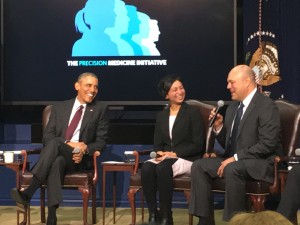Necessity as the father of innovation – Howard Look on sharing data, and a stage, with President Obama

Howard Look speaks as a part of the panel discussion held during the PMI Summit on February 25th while President Barack Obama looks on.
In 2011, Howard Look’s daughter Katie was diagnosed with Type 1 Diabetes. Look, a computer engineer who had previously worked at TiVo, Pixar, and Amazon, found the experience of accessing Katie’s health care data to be “like crawling through broken glass.” So he decided to do something about it.
Recently honored by the White House as a Precision Medicine Champion of Change, Howard is the founder and CEO of Tidepool, a nonprofit organization that is creating open source software to help Type 1 Diabetes patients liberate their data from diabetes devices and help them manage it on a secure, easy-to-use platform. His innovative work brought him to Medicine X in 2014 and 2015, and on February 25th, it took him back to the White House where he sat one seat away from the President of the United States to join him for a moderated panel discussion about the future of the Precision Medicine Initiative (PMI)!
Howard’s journey from technologist to health care innovator and thought leader exemplifies the ideals of Everyone Included™. Medicine X was excited to have the opportunity to interview Howard after his participation in the PMI Summit to learn more about the experience of sharing the stage with President Obama, and discuss his involvement with the Medicine X community.
In conversation with Howard Look
How were you initially approached with this opportunity?
Last year, I was one of the Precision Medicine Champions of Change. For [the White House Precision Medicine Initiative Summit], I got an email from Claudia Williams…and spoke with her.
When did you realize you were going to speaking on a panel with President Obama?
The panel wasn’t confirmed until Tuesday evening [two days before the event]. As you can imagine, it was pretty overwhelming and surreal!
What was the experience of being at the White House and on the panel like? What was going through your head during those moments?
I had to keep taking deep breaths to stay calm and remind myself to take it all in. My heart was racing the whole time (confirmed by my FitBit)! The President was amazing, calm, and thoughtful. We had a couple of “Dads of Daughters” moments together. I almost melted.
What are the key takeaway messages that you want to share regarding the Precision Medicine Initiative?
There are so many. Here are a few:
- By liberating data, amazing things happen. We empower patients and innovation.
- There is so much the community can contribute, especially when we think about breaking down traditional ways of thinking about research, development, and regulatory [practices].
- One size does not fit all when it comes to health care.
- Innovation can come from anywhere
What do you want the Medicine X community to know about the PMI?
The messages of MedX and Precision Medicine lead to the same thing: Empowered patients taking part in improving their health, and the notion that innovation can come from anywhere, not just white lab coated researchers!
How has being a part of the Medicine X community influenced your approach to health care and innovation?
The thing that I love about Medicine X is that I feel like I’ve found my people. Everybody who’s there believes in engaged patients being involved, in patient ownership of data, and in innovation that comes from anywhere. So it’s really inspiring to be there because it really feels like everyone has that same mindset that “We can do better,” and it doesn’t have to come from traditional research labs or white lab coat academics. It’s the mindset that health care innovation can really come from anyone.
What has been your favorite aspect of being involved with the Medicine X community?
Every time I see a talk by a patient or a parent or someone who decided to just go figure something out, I get inspired. Eric Topol is a good example, his talks are always inspiring. Matthew Might – I actually just saw him at the White House – He’s amazing. He just said “Ok, so I’m a professor of computer science, and yet my kid has this disease, so I’m going to go use my skills to go figure it out!” So every time I go see a talk like that, I am inspired.
What are your thoughts on the Everyone Included™ framework for health care innovation?
It resonates deeply [with me]. I love the tagline and I think it makes perfect sense. Every single person who is involved in health care, no matter how peripheral it may seem at first, they’re going to help you find the best possible solution. So the more people you can get involved, the more likely you are to happen upon the best possible solution!
Why do you think it is important to include all stakeholders in conversations about the future of health care? Based on your experience, why do you think we should “co-create?”
Well at the end of the day, you’re trying to build a solution that’s going to work for [all of these different stakeholders]. Probably the best lesson we [at Tidepool] got was when we were part of the inaugural class of Steve Blank’s “Lean LaunchPad for Life Sciences and Health Care” at UCSF. Steve’s got this mantra which is “Get out of the building.” The answers to your questions don’t exist inside your building, they exist when you get out and talk to the people that you’re trying to build things for. So when you apply that to health care solutions, if you’re not talking to the patient or the parents of the patient, or talking to the health care provider that’s going to be using your software, or talking to the researchers who would be using the data that your tools might generate – if you’re not talking to all those people early and often, you can’t possibly find the best solution for them. The only way to do it is to try things, iterate, show it to them, ask them what they think, get their feedback, iterate again – later, rinse, repeat!
What advice would you give to someone who wants to help fix problems in health care but is hesitant to do so because they don’t fit into the traditional categories of someone who is generally considered to be a health care problem solver?
The advice is “Just do it!” Empower yourself. Go seek out the information. Don’t be bashful. Make phone calls. Go camp out on people’s doorsteps. Read everything you possibly can on the Internet. Find people that think like you do and want to solve the same problem and just go do it! I think that’s the magic of all this – anyone can empower themselves. You don’t have to have gone to medical school, you don’t have to have training in the field. The information is out there and the right people to talk to are out there and you just need to empower yourself to go find them and catalyze change.
Have a question for Howard that wasn’t answered here? You can reach him on Twitter at @HowardLook, or by emailing him at howard@tidepool.org. Don’t forget to subscribe on our Medicine X | Precision Medicine page to be the first to receive all of our PMI updates!






very nice